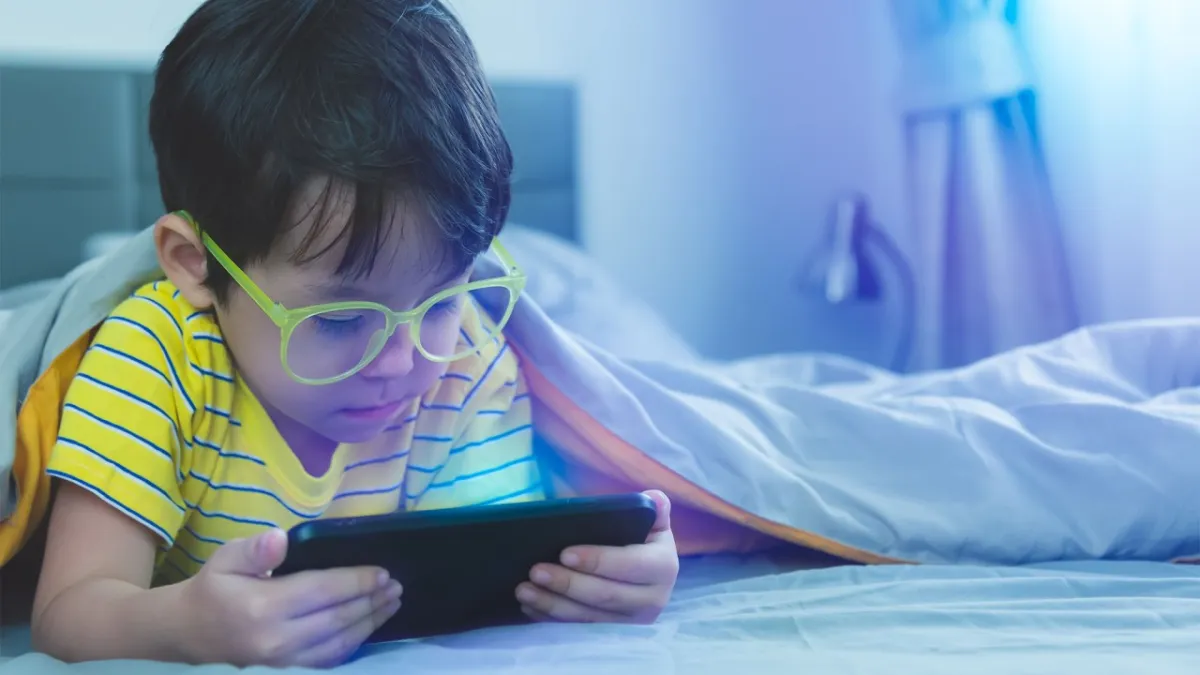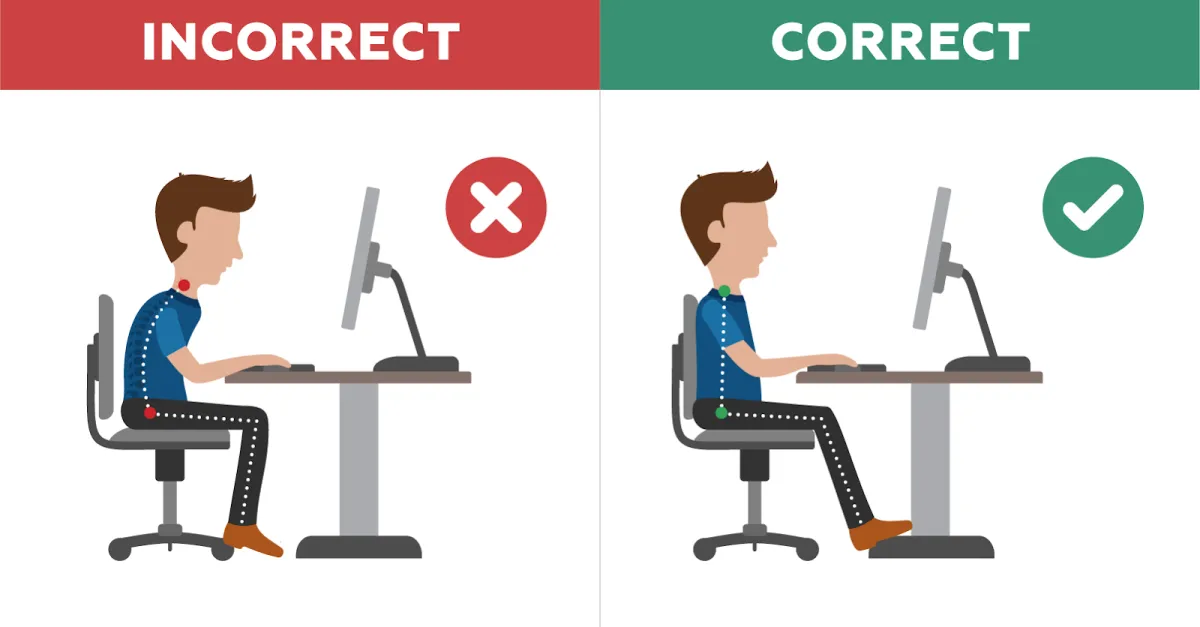Children's Vision
Exploring the Impact of Screen Time on Children's Vision
FSDAVCFEBFEVSDDVFSD
FSDAVCFEBFEVSDDVFSD
FSDAVCFEBFEVSDDVFSD
Causes of Screen-Induced Myopia
Recent studies have highlighted a strong link between screen time and the development of myopia, or nearsightedness, in children. The proximity of screens to the eyes during prolonged periods forces the eyes to focus intensely at a close range. This near focus can cause the eyeball to elongate over time, which can result in myopia. This risk increases with each additional hour of screen use per day.
The type of screen used also affects the risk levels, with computers showing the most substantial impact on child eye health. This is likely due to the fixed and close distance at which screens are typically held. Televisions also contribute to the risk, although less significantly than computers, while smartphones, surprisingly, did not show a significant correlation with myopia in children, highlighting the varied digital device impact on children’s eye safety.
Recent studies have highlighted a strong link between screen time and the development of myopia, or nearsightedness, in children. The proximity of screens to the eyes during prolonged periods forces the eyes to focus intensely at a close range. This near focus can cause the eyeball to elongate over time, which can result in myopia. This risk increases with each additional hour of screen use per day.

The type of screen used also affects the risk levels, with computers showing the most substantial impact on child eye health. This is likely due to the fixed and close distance at which screens are typically held. Televisions also contribute to the risk, although less significantly than computers, while smartphones, surprisingly, did not show a significant correlation with myopia in children, highlighting the varied digital device impact on children’s eye safety.

Addressing Digital Eye Strain
Digital eye strain, also known as computer vision syndrome, affects children who spend significant time on digital devices. Symptoms commonly include eye fatigue, dryness, blurry vision, and headaches. These symptoms arise because the eyes are strained from prolonged focus on screens, often exacerbated by poor blinking habits which are essential for maintaining eye moisture.
Encouraging children to blink more frequently can help alleviate dryness and irritation. Blinking spreads tears evenly over the surface of the eye, which is vital for keeping the eyes lubricated and comfortable. Inadequate blinking, common during long screen sessions, leads to dry and irritated eyes.
Implementing screen time guidelines like the 20/20/20 rule is a simple strategy to minimize digital eye strain. It suggests that the screen should be at least an elbow's length away from the eyes. This distance helps reduce strain as it provides a comfortable viewing range, preventing the need for the eyes to work harder to focus on objects near them.
Implement the 20/20 Rule in Child Routine

The 20/20/20 rule is a simple strategy to minimize digital eye strain. It suggests that every 20 minutes, you should take a break and look at something 20 feet away for 20 seconds. This practice helps relax the eye muscles, which can get fatigued from prolonged screen use.
Applying the 20/20/20 rule helps to counteract the tiredness your eyes feel after extended screen time. This break allows the eyes to adjust and focus on farther distances, giving the close-up focusing muscles a much-needed rest. It also encourages more frequent blinking, which is essential for moistening the eyes, often reduced when staring at screens.
To help children implement the 20/20/20 rule, parents can set alarms or use apps that remind kids to take eye breaks. Placing the computer near a window can also help, as it offers a natural distant view to look at during breaks. Encouraging children to stand and take a brief walk during these breaks can also be beneficial, not just for their eyes but for their overall posture and health.
The 20/20/20 rule is a simple strategy to minimize digital eye strain. It suggests that every 20 minutes, you should take a break and look at something 20 feet away for 20 seconds. This practice helps relax the eye muscles, which can get fatigued from prolonged screen use.
Applying the 20/20/20 rule helps to counteract the tiredness your eyes feel after extended screen time. This break allows the eyes to adjust and focus on farther distances, giving the close-up focusing muscles a much-needed rest. It also encourages more frequent blinking, which is essential for moistening the eyes, often reduced when staring at screens.

Educational activities can also be integrated into these breaks to make them more engaging and consistent. For instance, parents could encourage children to identify different objects or scenery outside the window during their 20-second gaze, turning it into a fun observational game. This not only ensures the children practice healthy eye habits but also keeps their minds active and engaged. Such interactive approaches can make adhering to the 20/20/20 rule more appealing and effective for young users.
To help children implement the 20/20/20 rule, parents can set alarms or use apps that remind kids to take eye breaks. Placing the computer near a window can also help, as it offers a natural distant view to look at during breaks. Encouraging children to stand and take a brief walk during these breaks can also be beneficial, not just for their eyes but for their overall posture and health.
Educational activities can also be integrated into these breaks to make them more engaging and consistent. For instance, parents could encourage children to identify different objects or scenery outside the window during their 20-second gaze, turning it into a fun observational game. This not only ensures the children practice healthy eye habits but also keeps their minds active and engaged. Such interactive approaches can make adhering to the 20/20/20 rule more appealing and effective for young users.
The Role of Outdoor Activities
Outdoor activities play a crucial role in mitigating the effects of prolonged screen time on children's eyesight. Spending time outdoors allows children to focus on distant objects, which is essential for relaxing the eye muscles that are otherwise constantly engaged during close-up screen activities. This shift in focus can help prevent the development of myopia (nearsightedness), which is increasingly common due to the extensive use of digital devices.
Research indicates that just an hour spent outdoors daily can significantly decrease the risk of developing myopia in children. Outdoor light exposure is particularly beneficial as it helps in the proper development of children's eyes. This not only helps in preventing myopia but also contributes to their overall physical and mental well-being, reducing sedentary habits and promoting a healthier lifestyle
Promoting Ergonomic Postures
Creating an ergonomic setup for children when using screens is crucial for preventing posture-related issues. Start by ensuring that the chair and desk fit the child's size. The chair should provide proper back support and allow the child to place their feet flat on the floor, with knees and elbows at about 90 degrees.
The computer screen should be positioned just below eye level to prevent neck strain. The screen must be directly in front of them to avoid any need for excessive turning or tilting of the head, which can lead to muscle strain over time.
Creating an ergonomic setup for children when using screens is crucial for preventing posture-related issues. Start by ensuring that the chair and desk fit the child's size. The chair should provide proper back support and allow the child to place their feet flat on the floor, with knees and elbows at about 90 degrees.
The computer screen should be positioned just below eye level to prevent neck strain. The screen must be directly in front of them to avoid any need for excessive turning or tilting of the head, which can lead to muscle strain over time.

Regularly changing the sitting position can also alleviate potential back and neck pain. Encourage children to stand and stretch at regular intervals, ideally every 20 to 30 minutes. This not only helps in reducing muscle fatigue but also enhances blood circulation, which is vital for maintaining energy and focus. Additionally, incorporating brief movement exercises can further promote better posture and overall physical well-being.

Regularly changing the sitting position can also alleviate potential back and neck pain. Encourage children to stand and stretch at regular intervals, ideally every 20 to 30 minutes. This not only helps in reducing muscle fatigue but also enhances blood circulation, which is vital for maintaining energy and focus.
Comprehensive Eye Care for Children
Regular eye exams at Kleinwood Vision are essential for maintaining the health of your child's eyes, especially in this digital age where children are exposed to screens frequently. These check-ups help identify and manage vision problems early, which can prevent complications that might affect your child's academic performance and overall quality of life. Children's vision is crucial for their overall development and learning. Eye problems, if undetected, can impair their ability to see clearly, which can hinder their educational and social activities. Regular eye check-ups can detect common visual issues such as myopia, hyperopia, and astigmatism early, ensuring that appropriate corrective measures can be taken promptly.
In addition to vision assessment, Kleinwood Vision provides personalized advice on preventing digital eye strain and promoting healthy vision habits. This includes guidance on the optimal setup for using digital devices, the importance of taking regular breaks (applying the 20-20-20 rule), and the benefits of UV protection. By maintaining regular visits, you can ensure that your child's vision health is supported by expert care tailored to their needs, allowing them to thrive both academically and socially.
Kleinwood Vision also emphasizes the importance of educating parents and children about the risks associated with excessive screen time. By understanding the potential for harm to their vision, families can take proactive steps to integrate healthier screen habits. This includes setting limits on screen use, ensuring proper lighting and screen distance, and incorporating protective measures like blue light filters. Regular eye exams also serve as an educational opportunity, where families can learn about eye health maintenance and receive updates on the latest eye care technologies and practices.
Why Eye Care Matters for Children?
Maintaining good eye health is crucial not just for clear vision but also for overall well-being. Regular eye check-ups play a vital role in detecting eye conditions early, which is essential for effective treatment and prevention of more serious complications. Conditions like myopia, hyperopia, and astigmatism, if left untreated, can significantly affect a child's learning and social interactions.

Maintaining good eye health is crucial not just for clear vision but also for overall well-being. Regular eye check-ups play a vital role in detecting eye conditions early, which is essential for effective treatment and prevention of more serious complications. Conditions like myopia, hyperopia, and astigmatism, if left untreated, can significantly affect a child's learning and social interactions.
Moreover, comprehensive eye exams can reveal more than just eye problems. They can also indicate other health issues such as diabetes and high blood pressure early on. This makes eye exams a critical part of maintaining general health. Practicing good eye care habits, such as protecting eyes from excessive sunlight with UV-blocking sunglasses and using protective eyewear during activities that could lead to eye injuries, is essential for preventing damage that can lead to vision loss.
Moreover, comprehensive eye exams can reveal more than just eye problems. They can also indicate other health issues such as diabetes and high blood pressure early on. This makes eye exams a critical part of maintaining general health. Practicing good eye care habits, such as protecting eyes from excessive sunlight with UV-blocking sunglasses and using protective eyewear during activities that could lead to eye injuries, is essential for preventing damage that can lead to vision loss.
How Kleinwood Vision Maintains Your Child’s Eye Health?
Scheduling a comprehensive eye evaluation at Kleinwood Vision is a proactive step in safeguarding your children's vision, particularly in this era where screen time is almost inevitable. Regular check-ups can help detect and manage any vision problems early, ensuring that your children's eyes are well-protected and their visual development is on track.
Visiting Kleinwood Vision provides more than just basic eye care; it offers personalized solutions tailored to meet the unique needs of each child, guided by experienced professionals. Whether it's adjusting to new glasses, handling eye strain, or addressing more complex vision issues, Kleinwood Vision is equipped to enhance your child's eye health and overall well-being. Don't wait for signs of eye problems; take action today to ensure their eyes are protected for tomorrow.

Contact Info
Hours of Operation
Mon - Fri | 9:00 AM - 5:00 PM
Sat - Sun | Closed
Holiday Hours: We are closed for the following holidays: New Years Day, Memorial Day, Independence Day, Labor Day, Thanksgiving Day, Christmas Day
© 2025 Kleinwood Vision. All rights Reserved.


